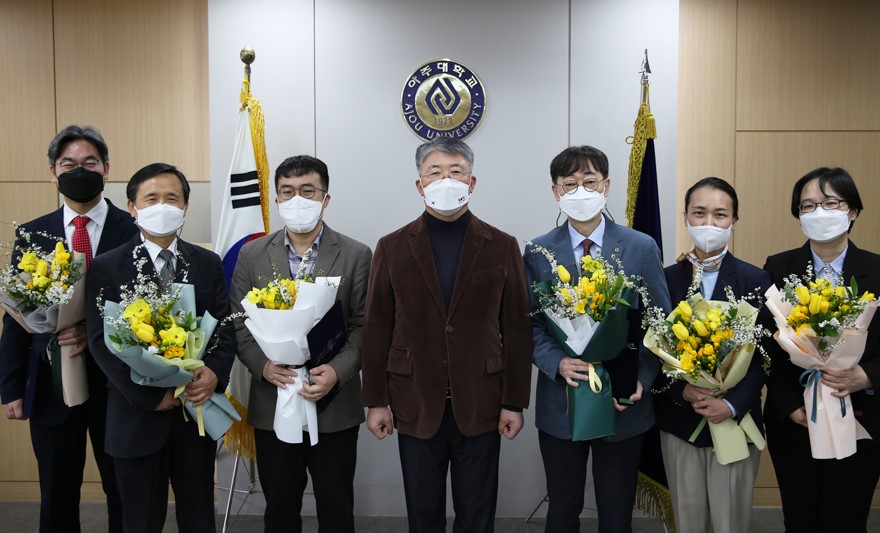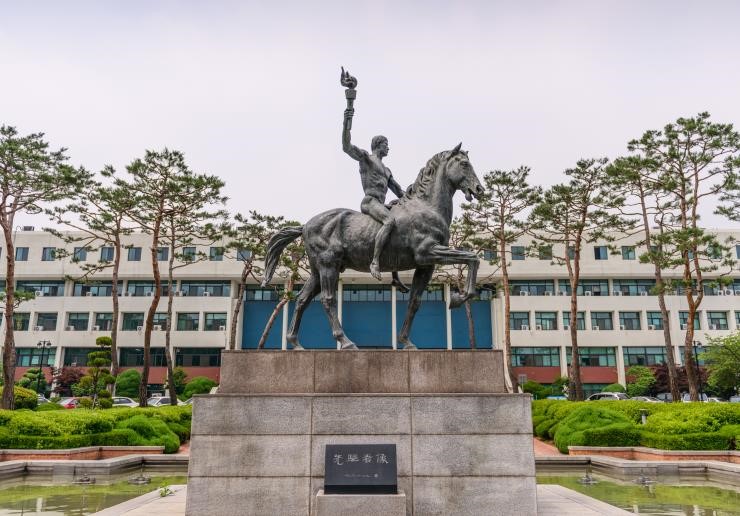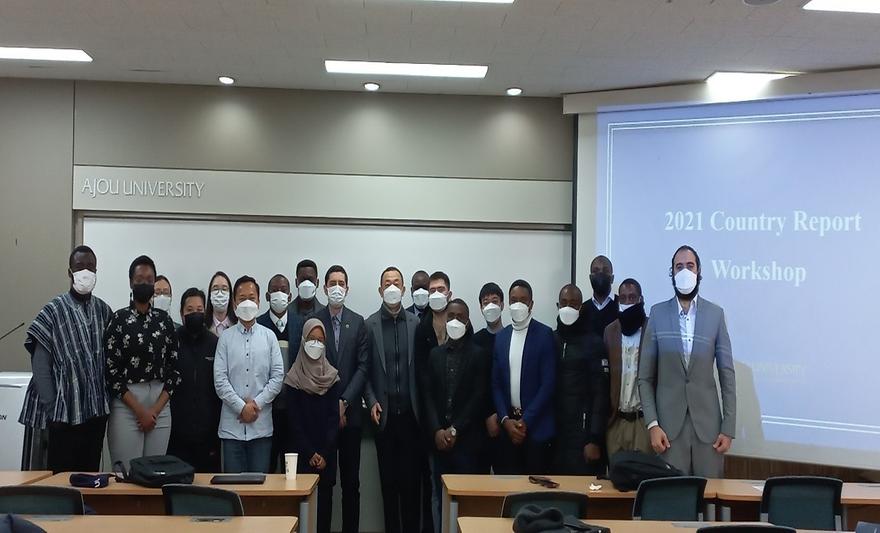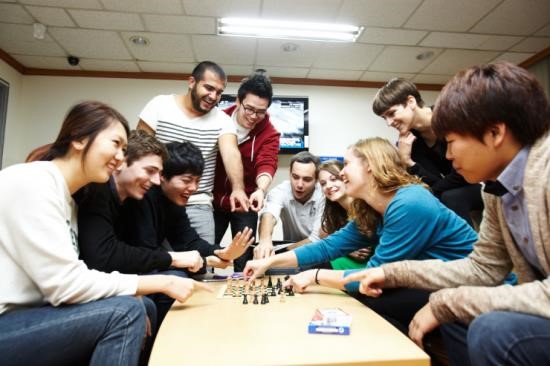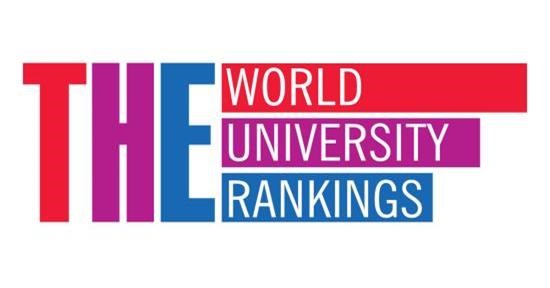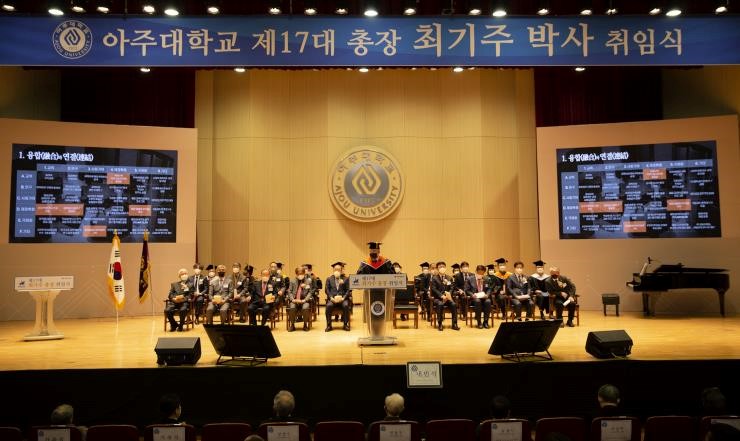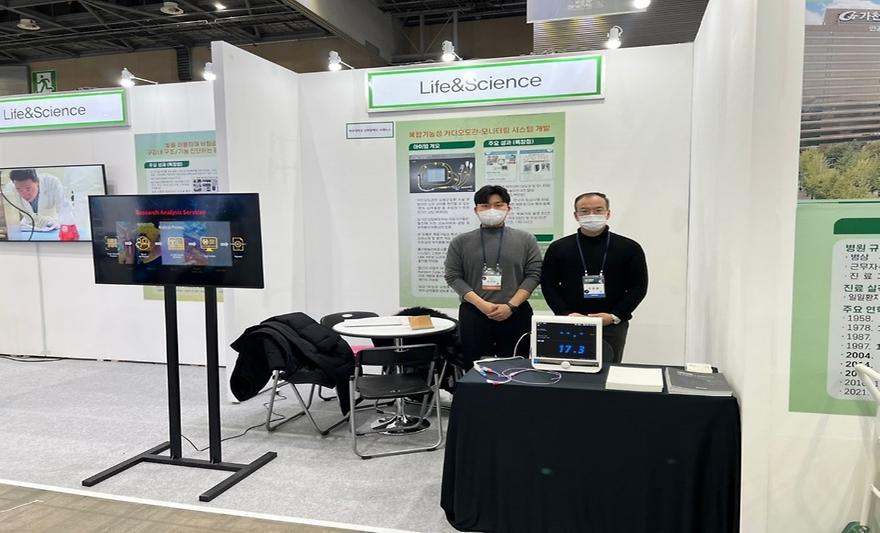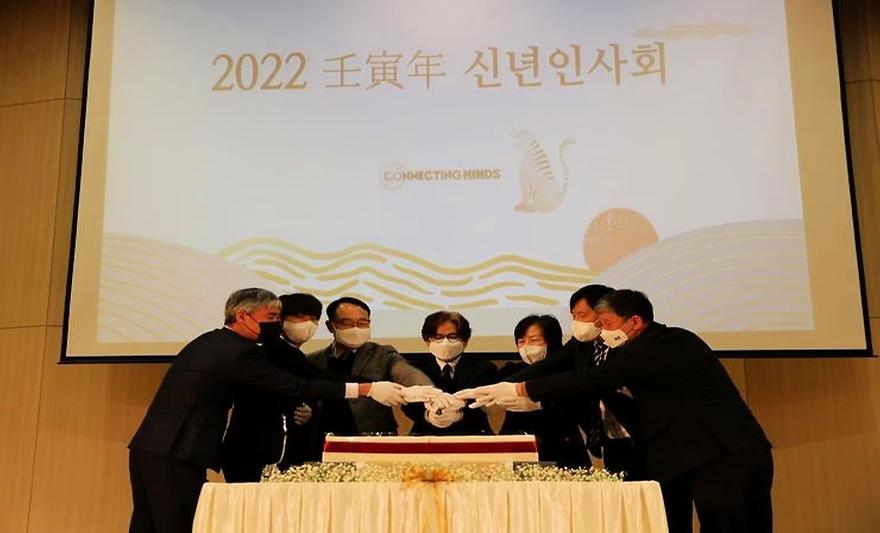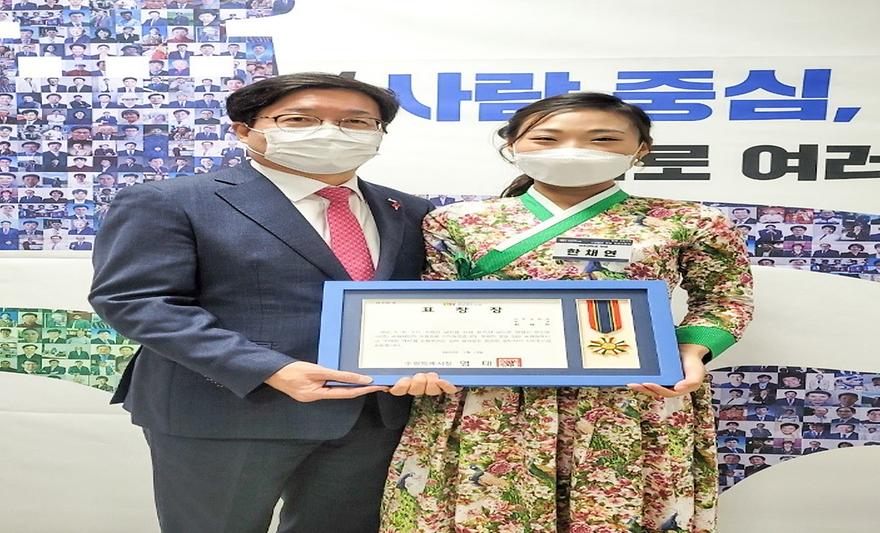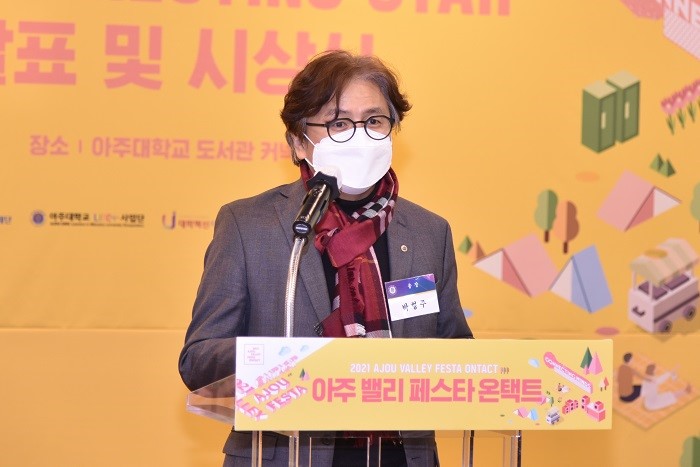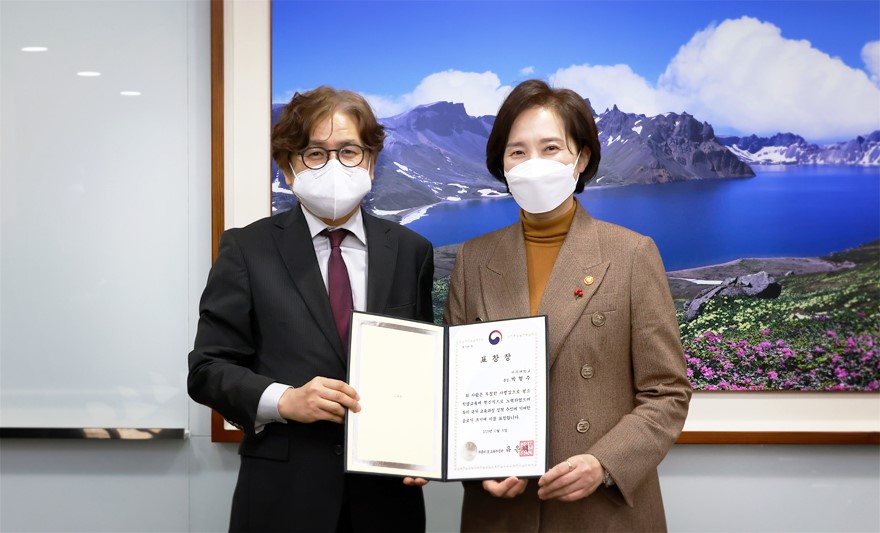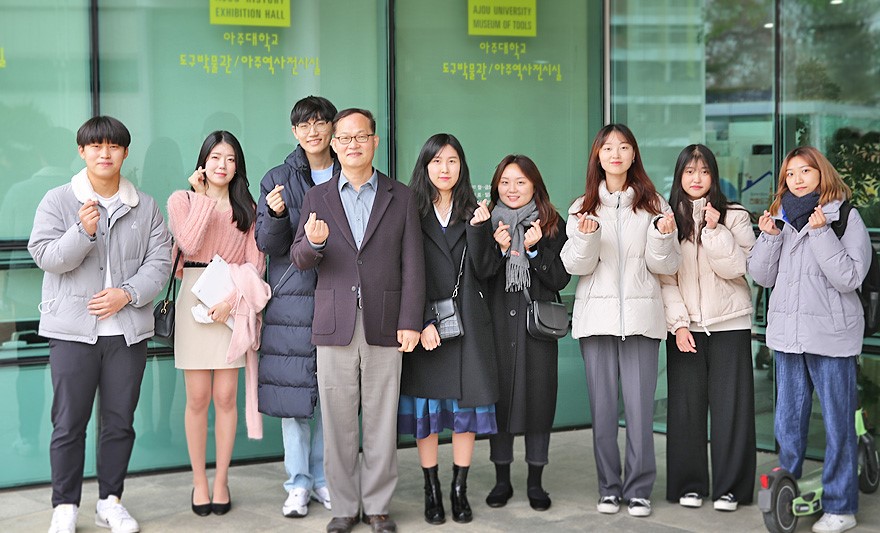-
-
554
- 작성자OIA
- 작성일2022-04-08
- 11220
- 동영상동영상
-
Ajou University gained the highest grade in the 2021 annual evaluation of the BRIDGE+ (Beyond Research Innovation & Development for Good Enterprises) Project hosted by the Ministry of Education and the National Research Foundation of Korea. Of the 24 universities nationwide taking part in this program, only Ajou University and three others received an A grade. The BRIDGE+ Project provides comprehensive support for activities enabling the practical use of intellectual property, covering its entire life cycle from patent creation to technology transfer and commercialization. It aims to expand the foundation for creating new national industries and revitalize the social contribution of universities through advancement of the practical use of creative assets within universities. The total project period is from 2018 to 2023.Through this project, participating universities strive to expand the practical use of convergence creative assets, promote the practical use of demand-based creative assets, strengthen the functions of organizations dedicated to technology transfer and commercialization, establish the foundation for a virtuous cycle for the practical use of creative assets, and engage in tasks to upgrade creative assets, among others.“It is very meaningful that our university’s support for pioneering research and technology commercialization and its outcomes have been recognized externally through acquisition of Grade A in the annual evaluation,” said Kim Sang-in, Head of the University-Industry Cooperation Foundation. He added, “We are committed to accelerating the technology commercialization process through Ajou University’s competitive edge.”Ajou University has consistently progressed well in commercializing its technology, seeing KRW 5.21 billion in technology transfer revenue in 2021, continuing its upward trend for the sixth consecutive year. This amount of revenue places the school among the top 5 universities in the country. In 2020, it ranked in the top 7 in Korea with KRW 3.35 billion in technology transfer revenue. Such outcomes are due to an efficient platform to support concrete and practical industry-university cooperation and technology commercialization.Technology commercialization refers to the monetization of results obtained through research activities by university researchers through technology transfers or start-ups. When it is successful, technology commercialization can maximize the utilization of research outcomes and contribute to the enhancement of corporate and national competitiveness and job creation.# Read articles from “Ajou Insight”—Ajou University’s seasonal newsletter ▶"We will achieve our dream of becoming the world’s top 100 business at Ajou”, An interview with two CEO Ajou professors▶Ajou University’s Top 7 Commercialized Technologies – Reaching beyond the boundaries of a university!
-
552
- 작성자OIA
- 작성일2022-04-08
- 11100
- 동영상동영상
-
Ajou University Graduate School of International Studies (GSIS) held a “Share Your Country Report” event where students studying in the KOICA-Ajou Scholarship Program for Masters’ Degrees (Energy Studies) gave presentations on their home countries.The event occurred in Yulgok Hall on March 22, 2022 and was attended by Jung Yong-hun, Department Chair of Energy Science and Policy, and 19 international students from 15 nations. Students in the masters’ degree program as part of the Korea International Cooperation Agency (KOICA) grant aid program are currently civil servants and public cooperation employees in their home countries.The Share Your Country Report event was titled, “The effect of Covid-19 and COP 26 on my country's energy field and market.” Students presented information on energy and related issues in their home countries, based on what they were studying at Ajou University. Students in the KOICA-Ajou Scholarship Program for Masters’ Degrees (Energy Studies) study energy policy, including energy independence, incubating energy industries, green growth, climate change response, and energy education.GSIS comprises six departments: International Business, International Trade, NGO Studies, International Development and Cooperation, Energy Studies, and Civil Society Studies.The KOICA-Ajou Scholarship Program for Masters’ Degrees (Energy Studies) aims toward the attainment of the UN Sustainable Development Goals (SDGs) by providing quality education, achieving economic development, enabling climate change response, and contributing to partnership building.
-
550
- 작성자OIA
- 작성일2022-04-08
- 10581
- 동영상동영상
-
Ajou University held an orientation session for international freshmen in the first semester of the 2022 academic year on Feb 24. Held online via Zoom® videoconferencing, the event was attended by some 400 international freshmen and exchange students from around the world who are entering the school’s undergraduate and graduate programs this semester. Ajou Global Ambassadors (AGA), an organization of Ajou students acting as global supporters, also joined in.The International Exchange and Cooperation Team holds an orientation session for international students at Ajou University every semester. This particular session proceeded with welcoming remarks, an introduction to the school, information on classes and school life, education to prevent sexual violence, and an introduction of the AGAs.The number of international exchange students in the first semester of this year is the largest ever—236 from 77 schools in 26 countries—and is the result of the university’s efforts to attract and effectively manage its international student body despite the ongoing COVID-19 challenges. By academic field, the School of Business accounted for the majority at around 50%, while the colleges of Engineering and Humanities accounted for 20%, respectively, followed by the College of Social Sciences at around 8%.“The number of international students studying at Ajou University is growing steadily,” said Son Jeong-houn, Vice President for International Affairs. “We will devote greater efforts to maintaining and developing Ajou’s global competitiveness.”Vice President Son added, “The number of exchange students at the School of Business has grown dramatically this semester. It has not been easy preparing and delivering classes in English. Yet, thanks to the support and efforts of the School of Business, every student has been able to sign up for their classes and prepare for life at Ajou.”Ajou University runs a variety of programs to assist international freshmen and exchange students, including AGAs, NUBI Ajou student volunteers, and Academic Mentors. International students at Ajou University can engage in cultural exchange activities through cultural programs and field trips and experience the national cultures of Korea and other countries.
-
548
- 작성자OIA
- 작성일2022-04-08
- 11050
- 동영상동영상
-
Ajou University ranked No. 1 among Korean universities in the Young University Rankings 2022 announced by the Times Higher Education (THE), a UK university evaluation institute. In Young University Rankings, THE conducts annual evaluations on universities established less than 50 years ago.THE Young University Rankings 2022 enjoyed the participation of 539 universities around the world. Evaluations were based on education, research, paper citations, globalization, and university-industry cooperation.Ajou University climbed to the No. 1 spot for Korean universities in this year’s evaluation. UNIST, POSTECH, and GIST, universities centering on specific affiliations, ranked in the top 1-3 in Korea, while Ajou University ranked 4th place. Its world ranking jumped 14 spots from last year to 138.The school scored higher across all evaluation items while particularly excelling in research and paper citations.Ajou University has made significant efforts to secure excellent teachers and strengthen its research capabilities. An Excellent Thesis Award has been set up which reflects quality evaluations, and settlement research funds awarded to new teachers have been revamped and increased. Newly appointed researchers can receive up to KRW 100 million if they are engaged in science and engineering, and up to KRW 50 million in humanities and social sciences. The period from the funding grant to submission of related outcomes has also been increased from three years to four, reflecting the university’s desire to help young, strong researchers devote themselves more to more challenging research goals. Financing research for postdoctoral researchers and actively inviting outstanding researchers through participation in overseas academic conferences are also another dimension of the school’s efforts to strengthen its research capabilities.The commitment of talented researchers and support from the university have boosted the school’s revenue from technology transfers to KRW 3.35 billion. This is the 7th largest for universities in Korea. Earnings from technology transfers amount to more than simply major financial outcomes of university and industry cooperation—they are also an indicator of the school’s research abilities. Ajou University has recorded year-on-year growth for five consecutive years in terms of the volume of technology transferred. Technology transfer revenue refers to the amount received by the university from companies seeking to utilize the research and development outcomes of researchers at the university to acquire related intellectual property rights.THE has announced the Young University Rankings since 2010, basing them on educational conditions (30%), research performance (30%), paper citations (30%), globalization (7.5%), and university-industry cooperation (2.5%). In this year’s Young University Rankings, PSL Research University in Paris topped the global ranking while Singapore’s Nanyang Technological University (NTU), Hong Kong University of Science and Technology, Erasmus University Rotterdam, and Hong Kong Polytech University also scored very highly.
-
546
- 작성자OIA
- 작성일2022-04-08
- 12446
- 동영상동영상
-
Choi Kee-choo, a professor in the Department of Transportation Systems Engineering at Ajou University, has been inaugurated as the university’s 17th President. The inauguration ceremony was held at Ajou’s Yeonam Hall on January 7, 2022 at 10:00 AM.Kwon Soon-jung, head of General Affairs, and announcer[KHTC1] Ha Ji-young served as masters of ceremony. Starting with an address by Daewoo Educational Foundation Chairman of the Board Choo Ho-suk, the ceremony proceeded with an introduction of the new president (by Han Ho, head of Academic Affairs), an inauguration speech by the new president, congratulatory addresses by distinguished guests from the university and from outside it, and singing of the school song (Park Sun-young, soprano).The ceremony was attended by members of the Ajou University community, representing its students and faculty, Chairman Choo, Standing Director Kim Sun-yong, and other related staff from the Daewoo Educational Foundation, as well as distinguished guests from academia, politics, and industry. Given the COVID-19 situation, the ceremony was also streamed live via Ajou University’s YouTube channel.In his address, Chairman Choo said, “In the almost 50 years since its foundation, Ajou University has achieved continuous growth, strengthening its position as a prestigious private institution.” He added, “This feat is because of the passion and devotion of every member of the Ajou family.”“The world is changing so quickly that if we don’t walk today, we will have to run tomorrow. We can no longer do things alone but need to work together with others,” continuing, “I hope 2022 will go down as the year we began building the foundation for new growth and advancement under the leadership of our new president and the commitment of all members of the university community. We ask for your warm encouragement and support for the new president, on whose shoulders lies this colossal task.”Congratulatory addresses were presented by Park Kwang-on (the National Assembly of the Republic of Korea member, Suwon 4th district), Chairman of the National Assembly of the Republic of Korea Land, Infrastructure, and Transport Committee Lee Hun-seung, Vice Chairman for the Ruling Party Cho Eung-cheon, Suwon City Mayor Yeom Tae-young, Kyungpook National University President Hong Won-hwa, Chairman of the Metropolitan Transport Commission Baek Seung-geun, and President of the Ajou University Alumni Association Choi Joong-won[KHTC2]. Congratulatory video messages were also delivered from Ajou University President Choi’s students who have advanced into academia at home and abroad. In his inauguration address, President Choi remarked, “As an expert in the transportation field who has paved the way for roads, railroads, skyways, and waterways throughout his life, I intend to spend the rest of my tenure blazing the path forward for Ajou University.” He added, “We will build a path for the University’s next 100 years upon the history of its past 50 years.”The new president asked three questions before revealing the direction forward and future plans. First, are we doing our best to build the foundation for future Ajou University students over the next 50 years? Second, are we sufficiently maximizing our potential? Third, are we sufficiently developing our founding philosophy?He continued his address by highlighting “convergence,” “connection,” “innovation,” “culture,” and other keywords, revealing his ambitions to set up a convergence education program, strengthen platform education, vitalize convergence research between departments, attract large-scale convergence research projects, expand connection with local, regional, and specialized universities and colleges, establish a specialized research center, improve infrastructure for the school and outside of it, bring innovation to the organizational culture, and construct cultural assets, among others.Near the end of his speech, he showed a video of how passengers worked together to save a person who had fallen between a subway train and platform. He emphasized the power of “togetherness” through “The Rule of Three”: As long as there are three people - one to propose pushing the train and two people to follow that person’s orders - the situation can be turned around in a second.He advised students, “Dream big, imagine big, and don’t be afraid of failure.”President Choi graduated from the Department of Civil Engineering (Urban Engineering) at Seoul National University, received a master's degree in transportation engineering from the same school, and acquired a doctorate in transportation planning from the University of Illinois at Urbana-Champaign [KHTC3]in the United States. Before becoming a professor in the Department of Transportation Systems Engineering at Ajou University in 1994, he worked as a senior researcher in the Urban Transportation Research Department at The Seoul Institute from 1992.[KHTC4]President Choi has been using his expertise in transportation engineering to engage actively in education and research as well as advising various institutions and local governments. He served as finance project evaluation member for the Ministry of Economy and Finance, member of the Central Urban Planning Committee[KHTC5] for the Ministry of Land, Infrastructure and Transport, chairman of the Bus Industry Development Council [KHTC6]for the Ministry of Land, Infrastructure and Transport, chairman of the Korean Committee of the WRA (World Road Association), and president of the Korean Society of Transportation. In 2019, he served as the first chairman (deputy minister level) of the Metropolitan Transport Commission for the Ministry of Land, Infrastructure, and Transport, helping to lay the foundation for the committee’s organization.The new president’s term of office will be for the four years of February 1, 2022 to January 31, 2026. <Academic procession to the inauguration ceremony> <Address by Daewoo Educational Foundation Chairman of the Board Choo Ho-suk > <Ajou University’s New President Choi Kee-choo revealing his plans and ambitions through his inauguration address> < Congratulatory Addresses: (From top left) National Assembly of the Republic of Korea Member Park Kwang-on, Suwon City Mayor Yeom Tae-young, National Assembly of the Republic of Korea Members Lee Hun-seung and Cho Eung-cheon >< Congratulatory Addresses: (Top photo) Ajou University Alumni Association President Choi Joong-won[KHTC1] (Bottom left) Kyungpook National University President Hong Won-hwa and Metropolitan Transport Commission Chairman Baek Seung-geun >
-
544
- 작성자OIA
- 작성일2022-02-11
- 10969
- 동영상동영상
-
A research team from Ajou University’s Polymer Biomaterials Laboratory exhibited their research outcomes at the 2021 Korea Science & Technology Fair.Occurring December 22—24, 2021 at KINTEX, the Fair comprised an exhibition and forum on the latest developments in science and technology, including in the fields of quantum technology, future defense, AI semiconductors, space, and advanced materials.The research team’s exhibit at the Fair was entitled, “Development of a multifunctional cardio conduit and monitoring system”[KHTC1] conducted in the Polymer Biomaterials Lab, headed by Professor Park Ki-dong (Department of Applied Chemistry and Biological Engineering, Graduate School Department of Molecular Science and Technology). The exhibit was presented and explained by Lee Si-min and Oh Dong-hwan[KHTC2], Ph.D. students in the Department of Molecular Science and Technology, who conducted the research.The incidence of cardiovascular disease among adults is increasing rapidly due to more countries becoming aged and aging societies and changes in diet and living environment. According to the World Health Organization (WHO), cardiovascular disease is the number one cause of death worldwide, directly or indirectly responsible for 31% of deaths around the globe. As a result, cardiovascular medical devices account for about 30% of the overall medical device market.The research team collaborated with a number of organizations to develop the first cardio conduit to monitor cardiac function in Korea, a nation currently dependent on imports. In order to control the side effects of thrombus and bacteria during long-term insertion into the body, a cardio conduit developed with antibacterial/antithrombotic properties applies the proprietary medical device surface immobilization technology of the Polymer Biomaterials Lab.In the course of its development, the Polymer Biomaterials Lab obtained a number of papers and patents and completed clinical trials, developing two prototypes and four technology transfers.Led by Professor Park Ki-dong, the Polymer Biomaterials Laboratory is developing functional biomaterials for the treatment of a variety of diseases, with research funded by the National Research Foundation of Korea. Lee Si-min (left) and Oh Dong-hwan (right), both Ph.D. students, taking part in the exhibition at the 2021 Korea Science & Technology Fair
-
542
- 작성자OIA
- 작성일2022-02-08
- 11281
- 동영상동영상
-
A ceremony heralding in the New Year on the morning of January 3, 2022, at the Grand Auditorium of Yeonam Hall was streamed live via YouTube.With Yoon Hae-jeong[KHTC1], head of the General Affairs Team, serving as MC, the ceremony began with screening a video on the steps by and major events at Ajou University in 2021. This was followed by a presentation of the Minister of Education Award to Director Choi Jeong-young [KHTC2]from the International Admissions Team, delivery of a New Year’s address by President Park Hyung-ju, a presentation by Shim Gyu-cheol, Director General [KHTC3]of the Office of Planning and Coordination on the school’s major achievements in 2021 and plans for 2022, New Year’s greetings by representatives of member institutions, and a rice cake cutting ceremony.President Park presented Ajou University’s latest achievements in relation to its core role in education and research and industry-university cooperation.“Ajou University, which will celebrate its 50th anniversary in 2023, has pioneered innovation in education in so many aspects,” said President Park, adding, “We continue to lead innovation in education, evidenced by our recent development of an AI-based education system tailored to students.”Director-General Shim presented major projects and achievements carried out in 2021 in relation to the five strategies of the school’s mid-long term development plan, summarized in Ajou Vision 4.0.Dr. Park Hae-shim (president, Ajou University Medical Center), Park Man-gyu (president, Ajou University School of Medicine Professoriate), Cho Jae-hyun (Ajou University Labor Union Leader), and Kim Hyeong-woo (president, Ajou University Student Council) conveyed their greetings on stage as representatives of their institutions.<Ajou University President Park Hyung-ju conveys his New Year’s greetings><Ajou University Student Council President Kim Hyeong-woo delivers his New Year’s greetings>
-
540
- 작성자OIA
- 작성일2022-02-08
- 10998
- 동영상동영상
-
Han Chae-yeon, a sociology student at Ajou University, was awarded the Suwon City Government Development Meritorious Citizen Commendation for her contribution to the development of the local community, culture, and tourism of Suwon City. The commendation is awarded to citizens who have contributed to the city government's advancement in various fields over the years of the 5th-7th mayoral terms (July 1, 2010 – June 2020).[KHTC1]Han (photo right) served as the first term Suwon Culture & Tourism Youth Ambassador [KHTC2]hosted by Ajou University’s Regional Cooperation Center (RCC) Hope and Nest Cooperative Federation from August to November 2020. The Youth Ambassador is a promotional position for local youths to identify and promote Suwon’s unique historical, cultural, and tourism resources to vitalize culture and tourism in Suwon and improve the city’s brand.Han was the leader of a team of seven ambassadors that planned projects to vitalize tourism in Suwon and promoted the city’s tourist destinations and activities both online and off. The team posted more than 40 promotional items through online SNS channels and produced a video entitled, “Shall we Suwon?” [KHTC3]introducing the city’s diverse food culture and attractions targeting the “MZ generation” – millennials (born 1981–1995) and Generation Z (born 1996–2010).[KHTC4]In addition, she actively participated in activities towards the development of the region, such as delivering a presentation on the direction of Suwon Special City at the Suwon Youth Autonomy and Decentralization On-tact Concert [KHTC5]as a youth participant [KHTC6]of the Suwon Autonomy and Decentralization Think-Tanks. [KHTC7]“I uploaded so many SNS posts to promote the information I’d learned while working as a tourist guide, which was effectively delivered to a large number of people through a variety of search terms,” she said, adding, “It was a meaningful experience because so many hours were dedicated to thinking about how to make a video and card news (a news format combining ‘cards’ featuring both text and images) [KHTC8]content targeting the MZ generation as a way to effectively promote Suwon’s culture and tourism.”The Regional Cooperation Center (RCC) was founded by Ajou University, in collaboration with several institutions and businesses in the region, as part of its LINC+ project in 2019. The RCC works to promote university-industry cooperation that can be directly relatable by the local community. Currently, it operates City Regeneration RCC (partner: Suwon Sustainable City Foundation), Smart Factory School RCC (partner: Korea SMEs and Startups Agency), SOS RCC (partner: Digital Empire II), and Social Economy RCC [KHTC9](partner: Hope and Nest Cooperative Federation). [KHTC1]5-7기의 기간을 설명하여 이해를 돕기 위해 추가된 부분입니다. [KHTC2]“수원시 문화관광 청년 홍보모델”[KHTC3]“우리 수원할까요?”[KHTC4]https://koreajoongangdaily.joins.com/2021/09/23/opinion/fountain/Generation-MZ-Generation-MZ-voters/20210923190240759.htmlMZ세대의 이해를 위하여 추가된 부분입니다.위의 기사를 참고하였습니다.[KHTC5]“수원시 청년 자치분권 온택트 콘서트”[KHTC6]크루 멤버인 것은 이해가 되나 영어 식 표현으로 했을 시에는 의미에 부합하지 않는 표현이라는 의견입니다. 승무원 등과 같은 그룹에게 해당되는 단어라는 의견입니다. 청년 참가자로 번역되었습니다. [KHTC7]“수원시 청년 자치분권 온택트 콘서트”[KHTC8]카드 뉴스는 콩글리시로 뒤에 부가설명을 덧붙였습니다.확인 부탁드립니다. [KHTC9]사회적경제 RCC
-
538
- 작성자OIA
- 작성일2022-02-08
- 11783
- 동영상동영상
-
2021 AJOU Valley Festa ONtact, a festival to promote the outcomes of cooperation between university and industry, was held with great success. With the participation of more than 6,000 people, the AJOU Valley Festa exhibition hall took place online from December 27 to 31, 2021 in an effort to curb the spread of COVID-19.Hosted by the Ministry of Education and the National Research Foundation of Korea (NRF) and managed by the Ajou University Leaders in Industry-University Cooperation (LINC), Ajou University Business Incubation Center, and the Ajou University Center for University Education Innovation, the festival highlighted the notable achievements of university-industry cooperation over the past year.A variety of programs were on offer for both members of the university family as well as partner businesses and the local community, including an exhibition on the major achievements of university-industry cooperation, notable cases of university-industry training and start-ups, an exhibition on what the Industrial Collaboration Center (ICC) and Regional Collaboration Center (RCC) have achieved, free consultation on legal, policy and patent matters, and corporate support for family businesses, seminars to enhance understanding of the 4th Industrial Revolution and businesses, and changes in the local community, meditation and humanities lectures to grant some mental rest for those exhausted from COVID-19 worries, and an event encouraging people to click ‘LIKE’ for their favorite exhibits. All exhibitions, events, and sessions were accessible via the online exhibition hall.The award ceremony for the “2021 AJOU Valley AWARDS – University-Industry Cooperation Connecting Star” took place on the afternoon of December 30. The awards commend organizations, businesses, and faculty for their work in training on university-industry cooperation, cooperation with businesses, and local community contributions throughout the year, as well as departments that contribute to university-industry cooperation projects and effect direct results from working actively to prevent the spread of COVID-19.The Industry-university Cooperation Award for outstanding students in-field practices, capstone design, entrepreneurship training, and industry-university cooperation training was also granted. The presentation of achievements and the awards ceremony itself were streamed live through the online exhibition hall, with students able to participate via the video conferencing platform.In his welcoming speech, President Park Hyung-ju stated, “Ajou University’s strength lies in intellectual capabilities in industry-university cooperation that resolves difficulties faced by businesses and local communities. […] This year, we achieved remarkable results, realizing more than 5 billion won in technology transfer revenue and ranking 2nd in the proportion of students participating in the JoongAng Daily University Rankings’ assessment field practice.”He added, “From our outstanding achievements over the years, we are continuing to move forward as a university that teaches well, conducts good research, solves social problems, and contributes to national growth through industry-university cooperation.”Ajou University has promoted the LINC+ project in education, university-industry research, and local community contributions towards creating “AJOU Valley,” an innovative ecosystem of connected intellectual university-industry cooperation involving universities, businesses, and local communities working together and without boundaries. Despite challenges presented by the prolongation of COVID-19, new achievements have been seen in each field through domestic and international cooperation.The online exhibition hall where AJOU Valley Festa ONtact was held will remain in operation even after the event to continuously promote the achievements of Ajou University’s industry-university cooperation.# Go to Online Exhibition Hall ▶lincplusfesta.ajou.ac.kr# Watch presentation of achievements and awards ceremony ▶https://youtu.be/6m2SuLxMcwAConnecting Star Awards for Exemplary Affiliated BusinessesConnecting Star Awards for Exemplary Partners of Industry-university CooperationIndustry-university Cooperation Award Ceremony for Students<Award recipients>Part 1. Industry-university Cooperation Connecting Star Presentation of Achievements – AJOU Valley Awards[Exemplary Partners of Industry-university Cooperation]▲Korea Institute of Science and Technology (KIST) (President: Dr. Yoon Seok-jin) ▲Korea Industry Intelligentization Association (Chairman: Kim Tae-hwan) ▲Drone School International (CEO: Cho Hyeon-joon)[Exemplary Affiliated Businesses]▲Genesen (CEO: Lee Seong-ho) ▲United Digital Manufacturing Technology (UDMTEK) (CEO: Wang Gi-nam) ▲Kyulajen (CEO: Kim Dong-hoon) ▲Morai (CEO: Jeong Ji-won, Hong Joon) ▲S&D Powernics (CEO: Choi Seung-hee) ▲Panoptics (CEO: Kim Jang-seon) ▲A&K (CEO: Kim Jae-ho) ▲The.Wave.Talk (CEO: Kim Young-deok)[Exemplary Faculty Contributors]▲ICC Sector: Kim Sang-in (Electronic engineering) ▲ICC Sector: Song Bong-seop (Mechanical engineering) ▲ University-Industry Training Sector: Kim Young-ho (LINC+) ▲University-Industry Training Sector: Lee Kang-hyeon (LINC+) ▲ University-Industry Training Sector: Park Sa-hyeon (LINC+)[Exemplary Staff Contributors]▲Kim Dong-hyeon (Project Management office of AUT) ▲Kang Min-cheol (Industry-university Supporting Team of the Industry-university Cooperation Institute) ▲Choi Yeon-soo (Faculty Affairs Team of the Office of Academic Affairs)[ONtact Industry-university Cooperation Contributors]▲ Purchasing and Property Management Team [KHTC1]in the Office of General Affairs / Industry-university Purchasing Team [KHTC2]in the Industry-university Cooperation Foundation (contribution to the construction of infrastructure for contactless industry-university cooperation training and research), ▲ Industry-university Accounting Team [KHTC3]in the Industry-university Cooperation Foundation (contribution to construction of industry-university cooperation infrastructure, promotion of family membership system, improvement of project performance, including construction of ICC)Part 2. Industry-university Cooperation Awards for Students[2nd Suwon Sustainable City UCC Contest]▲Grand Prize: Design Room Fairies (Chae Soo-jeong and Kang Min-jeong) ▲Participation Prize: Yeorohaesalyi (Kim Ye-seul, Park Kyoung-jin, and Kim Sang-beom, Han Chang-hee ▲Participation Prize: Soji (Park So-min)[2021 APC Programming Contest]▲Grand Prize: Park Joo-hyeon and Han Sang-hyeok ▲ First Prize: Song Seon-woo and Lee Bong-hak ▲Excellence Prize: Jeon Min-gyu, Lee Chang-yeop, Park Hae-rim, Cho Woo-yeon, and Jeong Tae-gyu ▲Participation Prize: Kim Young-gil, Joo Jeong-ho, and Kim Gyu-hwan[2021 Ajou University Deep Learning Challenge]▲Grand Prize: Kim Hae-jin ▲ First Prize: Park Jong-hyeok ▲ Excellence Prize: Han Cheol-hwa, Sohn Ji-ah, Lee Dong-geon, Kim Hoe-min, Kim Tae-hong, and Yu Ju-won[4th Industry-university Cooperation Review Awards]▲First Prize: Chae Jeong-woo and Hwang Hyeon-seok, Excellence Prize: Sim So-eun, Kim Yong-joon, and Jeong Jin-ah ▲Participation Prize: Choi Jae-wook, Lee June-soo, Kim Hae-bin, Jo Jeong-wang, and Kang Jin-woo[15th Field Training Review Contest]▲Grand Prize: Lee Hae-rang ▲ First Prize: Lee Hae-jin, Park Jeong-seon, Maeng Hee-seon, and Shin Ye-ji ▲Excellence Prize: Oh Soo-bin, Sohn Min-jae, Ahn So-yeon, Goo Ji-eun, and Jeong Jae-yeop ▲ Participation Prize: Bae Soo-bin, Kang Byeong-soo, Lee Ji-yeop, Jang Jae-hyeok, Kim Kyu-ae, Jeong Jae-yeop[KHTC4], Kim Sae-hyeong, Sim So-eun, Lee Hyeon-woo, and Shin Ji-woo[14th Capstone Design Contest]▲Grand Prize: AI Teacher (Lee Byeong-han, Kim Ji-hyeon, Song Sang-gyu, and Hwang Sang-min ▲ First Prize: DA (Song Ji-yeon, Goh Ye-joon, Woo Na-yeong, Lee Seung-hyeon, and Choi Jeong-min, 213(Seong Hyeon-ji and Cha Ha-eun ▲Excellence Prize: Sally (Seon Woo-chan, Kim Chang-hee, Ahn Seong-min, and Kwon Min-hoe), Together (Jeong Seok-hwa, Kim So-yi, Kim Joo-yoon, Lee Min-ha, and Jang Jae-wook), Mangjeong (Moon Ji-hyeon, Lee So-yeon, and Jeong Yoon-joo), FAT (Yeon Jeong-heun, Jeong Yeon-woo, Kim Da-san, and Jang Jae-hoon) ▲Participation Prize: Opinio (Shin Dong-hoon, Yoon Min-sang, Kim Young-woo, Lee Sang-woong, and Lee Yae-bin), Connect (Kim Dong-hyeon, Gong Min-jeong, Kim Hee-seung, Park Min-woo, and Soh Hyeon-young), Happiness and Justice Team (Lee Seung-hee, Kim Soo-bin, and Jeong Ah-ram), Princess Rapunzel of COVID-19 Kingdom Team (Yoon Jin-won, Hwang Ji-yeon, Kim Tae-joon, and Cho Jeong-ho), Haengseman Team (Ha Hyo-ryoung, Lee Ji-heon, and Park Joon-hyeon)[5th LINC+ Humanities & Social Studies Capstone Design Exhibition]▲First Prize: Ajou Gosaeng (Yang Soo-jin, Kim Da-jeong, Lee Soo-yeon, and Lee Seul-bee), ▲ Excellence Prize: Mooncorngi 8Jo (Kim Gyeong-eun, BUI, THI HANH, and Kim Soo-hyeon) ▲Participation Prize: GRAVITY (Yoon Jeong-min, Kwon Hyeon-jin, Park Ga-eul, and Yoo Jeong-hyeon), Who is The Villain (Lee Chan, Jeong Ye-rim, Yu Jeong-soo), Ajou Taco (Yoon Ho-sang, Park Yong-won, and Shin Joon-seop)[7th LINC+ Entrepreneurship Idea Contest – Curricular Category]▲First Prize: Sigma.i (Gong Min-tae and Ahn Ye-young) ▲Excellence Prize: Clustering Oil Fence (Lee Ho-joon), FORECO (Kim Ye-won, Jeong Se-won, TRAN THI QUYNHNHUT, Bae Geon-hee, Kang Min-seok, and Sohn Jeong-ho), Butterfly Effect (Seo Jeong-won, Park Eun-seong, Choi Gwang-hee, and Choi Woo-ho) ▲Participation Prize: Multicultural Family (Lee Joon-yeop, Jeong Rae-seong, Yeom Won-seop, and Lee Seung-yoon), Don’t Want to Buy! (Han Joo-hyeon), Oh My Jo (Kim Jin-hee, Han Soo-hyeon, Yoon Yeo-song, Hong Seong-pyo, and Moon Joon-hyeok), Kim Ee-hwang (Lee Jae-seok, Kim Geun-yeong, Kim Jong-chan, Lee Jeong-ah, and Hwang Shin-cheol), Inheritance (Heo Jin, Hyeon Soo-hwan, Quan Chuyan, Gwon Ye-jin)[7th LINC+ Entrepreneurship Idea Competition – Extracurricular Category]▲Grand Prize: Nudge (Min Jeong-geun, Ryu Hyeon-jin, Ryu Chang-hyeon, Song Ah-young, and Jeong Il-joo) ▲First Prize: Hyangyoo (Seo Ji-yoon, Eom Yoo-jin, Yoon So-yeon, and Hwang Hyeon-ji) ▲Excellence Prize: R.A.D (Jang Hyeon-soo, Jang Young-il, and Choi Myeong-soo), Hada (Lee Seung-hyeon, Bang Jin-hyeok, Kang Seon-ho, and Lee Beom-soo) ▲Participation Prize: Dis-reality (Choi Seon, Kim Eun-seo, Kim Ye-jin, Jeong Min-ji, Seo Eui-soo, Yang Ji-min, and Kim Ye-eun), Kim Ri-hyeon (Kim Ri-hyeon and Jo Seong-ho), KTEEN (Kwon Ji-han, Kim Jin-won, and Song Young-beom), Couple: The (Baek Se-hee, Bae Mi-ran, Kim Yoo-eun, Park Jin-young, and Shin Eun-joo), Fork Fork (Cho Ye-jin, Kang Hae-won, Jang Hyo-taek, and Kang Tae-yoon)[KHTC1]구매관재팀[KHTC2]산학구매팀[KHTC3]산학재무팀[KHTC4]정재엽 학생은 장려상과 우수상을 다 받는 분일까요? 아니면 동명이인이실까요?혹시 몰라 메모 남겼습니다.2021 AJOU Valley Festa ONtact, a festival to promote the outcomes of cooperation between university and industry, was held with great success. With the participation of more than 6,000 people, the AJOU Valley Festa exhibition hall took place online from December 27 to 31, 2021 in an effort to curb the spread of COVID-19.Hosted by the Ministry of Education and the National Research Foundation of Korea (NRF) and managed by the Ajou University Leaders in Industry-University Cooperation (LINC), Ajou University Business Incubation Center, and the Ajou University Center for University Education Innovation, the festival highlighted the notable achievements of university-industry cooperation over the past year.A variety of programs were on offer for both members of the university family as well as partner businesses and the local community, including an exhibition on the major achievements of university-industry cooperation, notable cases of university-industry training and start-ups, an exhibition on what the Industrial Collaboration Center (ICC) and Regional Collaboration Center (RCC) have achieved, free consultation on legal, policy and patent matters, and corporate support for family businesses, seminars to enhance understanding of the 4th Industrial Revolution and businesses, and changes in the local community, meditation and humanities lectures to grant some mental rest for those exhausted from COVID-19 worries, and an event encouraging people to click ‘LIKE’ for their favorite exhibits. All exhibitions, events, and sessions were accessible via the online exhibition hall.The award ceremony for the “2021 AJOU Valley AWARDS – University-Industry Cooperation Connecting Star” took place on the afternoon of December 30. The awards commend organizations, businesses, and faculty for their work in training on university-industry cooperation, cooperation with businesses, and local community contributions throughout the year, as well as departments that contribute to university-industry cooperation projects and effect direct results from working actively to prevent the spread of COVID-19.The Industry-university Cooperation Award for outstanding students in-field practices, capstone design, entrepreneurship training, and industry-university cooperation training was also granted. The presentation of achievements and the awards ceremony itself were streamed live through the online exhibition hall, with students able to participate via the video conferencing platform.In his welcoming speech, President Park Hyung-ju stated, “Ajou University’s strength lies in intellectual capabilities in industry-university cooperation that resolves difficulties faced by businesses and local communities. […] This year, we achieved remarkable results, realizing more than 5 billion won in technology transfer revenue and ranking 2nd in the proportion of students participating in the JoongAng Daily University Rankings’ assessment field practice.”He added, “From our outstanding achievements over the years, we are continuing to move forward as a university that teaches well, conducts good research, solves social problems, and contributes to national growth through industry-university cooperation.”Ajou University has promoted the LINC+ project in education, university-industry research, and local community contributions towards creating “AJOU Valley,” an innovative ecosystem of connected intellectual university-industry cooperation involving universities, businesses, and local communities working together and without boundaries. Despite challenges presented by the prolongation of COVID-19, new achievements have been seen in each field through domestic and international cooperation.The online exhibition hall where AJOU Valley Festa ONtact was held will remain in operation even after the event to continuously promote the achievements of Ajou University’s industry-university cooperation.# Go to Online Exhibition Hall ▶lincplusfesta.ajou.ac.kr# Watch presentation of achievements and awards ceremony ▶https://youtu.be/6m2SuLxMcwAConnecting Star Awards for Exemplary Affiliated BusinessesConnecting Star Awards for Exemplary Partners of Industry-university CooperationIndustry-university Cooperation Award Ceremony for Students<Award recipients>Part 1. Industry-university Cooperation Connecting Star Presentation of Achievements – AJOU Valley Awards[Exemplary Partners of Industry-university Cooperation]▲Korea Institute of Science and Technology (KIST) (President: Dr. Yoon Seok-jin) ▲Korea Industry Intelligentization Association (Chairman: Kim Tae-hwan) ▲Drone School International (CEO: Cho Hyeon-joon)[Exemplary Affiliated Businesses]▲Genesen (CEO: Lee Seong-ho) ▲United Digital Manufacturing Technology (UDMTEK) (CEO: Wang Gi-nam) ▲Kyulajen (CEO: Kim Dong-hoon) ▲Morai (CEO: Jeong Ji-won, Hong Joon) ▲S&D Powernics (CEO: Choi Seung-hee) ▲Panoptics (CEO: Kim Jang-seon) ▲A&K (CEO: Kim Jae-ho) ▲The.Wave.Talk (CEO: Kim Young-deok)[Exemplary Faculty Contributors]▲ICC Sector: Kim Sang-in (Electronic engineering) ▲ICC Sector: Song Bong-seop (Mechanical engineering) ▲ University-Industry Training Sector: Kim Young-ho (LINC+) ▲University-Industry Training Sector: Lee Kang-hyeon (LINC+) ▲ University-Industry Training Sector: Park Sa-hyeon (LINC+)[Exemplary Staff Contributors]▲Kim Dong-hyeon (Project Management office of AUT) ▲Kang Min-cheol (Industry-university Supporting Team of the Industry-university Cooperation Institute) ▲Choi Yeon-soo (Faculty Affairs Team of the Office of Academic Affairs)[ONtact Industry-university Cooperation Contributors]▲ Purchasing and Property Management Team in the Office of General Affairs / Industry-university Purchasing Team in the Industry-university Cooperation Foundation (contribution to the construction of infrastructure for contactless industry-university cooperation training and research), ▲ Industry-university Accounting Team in the Industry-university Cooperation Foundation (contribution to construction of industry-university cooperation infrastructure, promotion of family membership system, improvement of project performance, including construction of ICC)Part 2. Industry-university Cooperation Awards for Students[2nd Suwon Sustainable City UCC Contest]▲Grand Prize: Design Room Fairies (Chae Soo-jeong and Kang Min-jeong) ▲Participation Prize: Yeorohaesalyi (Kim Ye-seul, Park Kyoung-jin, and Kim Sang-beom, Han Chang-hee ▲Participation Prize: Soji (Park So-min)[2021 APC Programming Contest]▲Grand Prize: Park Joo-hyeon and Han Sang-hyeok ▲ First Prize: Song Seon-woo and Lee Bong-hak ▲Excellence Prize: Jeon Min-gyu, Lee Chang-yeop, Park Hae-rim, Cho Woo-yeon, and Jeong Tae-gyu ▲Participation Prize: Kim Young-gil, Joo Jeong-ho, and Kim Gyu-hwan[2021 Ajou University Deep Learning Challenge]▲Grand Prize: Kim Hae-jin ▲ First Prize: Park Jong-hyeok ▲ Excellence Prize: Han Cheol-hwa, Sohn Ji-ah, Lee Dong-geon, Kim Hoe-min, Kim Tae-hong, and Yu Ju-won[4th Industry-university Cooperation Review Awards]▲First Prize: Chae Jeong-woo and Hwang Hyeon-seok, Excellence Prize: Sim So-eun, Kim Yong-joon, and Jeong Jin-ah ▲Participation Prize: Choi Jae-wook, Lee June-soo, Kim Hae-bin, Jo Jeong-wang, and Kang Jin-woo[15th Field Training Review Contest]▲Grand Prize: Lee Hae-rang ▲ First Prize: Lee Hae-jin, Park Jeong-seon, Maeng Hee-seon, and Shin Ye-ji ▲Excellence Prize: Oh Soo-bin, Sohn Min-jae, Ahn So-yeon, Goo Ji-eun, and Jeong Jae-yeop ▲ Participation Prize: Bae Soo-bin, Kang Byeong-soo, Lee Ji-yeop, Jang Jae-hyeok, Kim Kyu-ae, Jeong Jae-yeop, Kim Sae-hyeong, Sim So-eun, Lee Hyeon-woo, and Shin Ji-woo[14th Capstone Design Contest]▲Grand Prize: AI Teacher (Lee Byeong-han, Kim Ji-hyeon, Song Sang-gyu, and Hwang Sang-min ▲ First Prize: DA (Song Ji-yeon, Goh Ye-joon, Woo Na-yeong, Lee Seung-hyeon, and Choi Jeong-min, 213(Seong Hyeon-ji and Cha Ha-eun ▲Excellence Prize: Sally (Seon Woo-chan, Kim Chang-hee, Ahn Seong-min, and Kwon Min-hoe), Together (Jeong Seok-hwa, Kim So-yi, Kim Joo-yoon, Lee Min-ha, and Jang Jae-wook), Mangjeong (Moon Ji-hyeon, Lee So-yeon, and Jeong Yoon-joo), FAT (Yeon Jeong-heun, Jeong Yeon-woo, Kim Da-san, and Jang Jae-hoon) ▲Participation Prize: Opinio (Shin Dong-hoon, Yoon Min-sang, Kim Young-woo, Lee Sang-woong, and Lee Yae-bin), Connect (Kim Dong-hyeon, Gong Min-jeong, Kim Hee-seung, Park Min-woo, and Soh Hyeon-young), Happiness and Justice Team (Lee Seung-hee, Kim Soo-bin, and Jeong Ah-ram), Princess Rapunzel of COVID-19 Kingdom Team (Yoon Jin-won, Hwang Ji-yeon, Kim Tae-joon, and Cho Jeong-ho), Haengseman Team (Ha Hyo-ryoung, Lee Ji-heon, and Park Joon-hyeon)[5th LINC+ Humanities & Social Studies Capstone Design Exhibition]▲First Prize: Ajou Gosaeng (Yang Soo-jin, Kim Da-jeong, Lee Soo-yeon, and Lee Seul-bee), ▲ Excellence Prize: Mooncorngi 8Jo (Kim Gyeong-eun, BUI, THI HANH, and Kim Soo-hyeon) ▲Participation Prize: GRAVITY (Yoon Jeong-min, Kwon Hyeon-jin, Park Ga-eul, and Yoo Jeong-hyeon), Who is The Villain (Lee Chan, Jeong Ye-rim, Yu Jeong-soo), Ajou Taco (Yoon Ho-sang, Park Yong-won, and Shin Joon-seop)[7th LINC+ Entrepreneurship Idea Contest – Curricular Category]▲First Prize: Sigma.i (Gong Min-tae and Ahn Ye-young) ▲Excellence Prize: Clustering Oil Fence (Lee Ho-joon), FORECO (Kim Ye-won, Jeong Se-won, TRAN THI QUYNHNHUT, Bae Geon-hee, Kang Min-seok, and Sohn Jeong-ho), Butterfly Effect (Seo Jeong-won, Park Eun-seong, Choi Gwang-hee, and Choi Woo-ho) ▲Participation Prize: Multicultural Family (Lee Joon-yeop, Jeong Rae-seong, Yeom Won-seop, and Lee Seung-yoon), Don’t Want to Buy! (Han Joo-hyeon), Oh My Jo (Kim Jin-hee, Han Soo-hyeon, Yoon Yeo-song, Hong Seong-pyo, and Moon Joon-hyeok), Kim Ee-hwang (Lee Jae-seok, Kim Geun-yeong, Kim Jong-chan, Lee Jeong-ah, and Hwang Shin-cheol), Inheritance (Heo Jin, Hyeon Soo-hwan, Quan Chuyan, Gwon Ye-jin)[7th LINC+ Entrepreneurship Idea Competition – Extracurricular Category]▲Grand Prize: Nudge (Min Jeong-geun, Ryu Hyeon-jin, Ryu Chang-hyeon, Song Ah-young, and Jeong Il-joo) ▲First Prize: Hyangyoo (Seo Ji-yoon, Eom Yoo-jin, Yoon So-yeon, and Hwang Hyeon-ji) ▲Excellence Prize: R.A.D (Jang Hyeon-soo, Jang Young-il, and Choi Myeong-soo), Hada (Lee Seung-hyeon, Bang Jin-hyeok, Kang Seon-ho, and Lee Beom-soo) ▲Participation Prize: Dis-reality (Choi Seon, Kim Eun-seo, Kim Ye-jin, Jeong Min-ji, Seo Eui-soo, Yang Ji-min, and Kim Ye-eun), Kim Ri-hyeon (Kim Ri-hyeon and Jo Seong-ho), KTEEN (Kwon Ji-han, Kim Jin-won, and Song Young-beom), Couple: The (Baek Se-hee, Bae Mi-ran, Kim Yoo-eun, Park Jin-young, and Shin Eun-joo), Fork Fork (Cho Ye-jin, Kang Hae-won, Jang Hyo-taek, and Kang Tae-yoon)
-
536
- 작성자OIA
- 작성일2022-02-08
- 12336
- 동영상동영상
-
-
534
- 작성자OIA
- 작성일2022-02-08
- 11011
- 동영상동영상
-
Students from Ajou University received “The 24th Citizen's Criticism Award for Good Broadcasting.”In deliberations for “The 24th Citizen's Criticism Award for Good Broadcasting” hosted by the Foundation for Broadcast Culture on December 11, 2021, the work of nine students from Ajou University won honorable mention and were selected for the award. This is a splendid feat following last year’s achievement where five students received awards.Students entered the contest after studying the theory of criticism in content & text and the method for analysis by taking lectures in the Media Text Analysis Workshop and Broadcast Content Planning course taught by Professor Hong Kyung-soo from the Department of Culture and Contents.In the contest, Na Eun-jeong, a student in the Department of Culture and Contents, won honorable mention for her critique of the Crimetrivia aired on tvN, title “Regrettable lack of density, dictionary of miscellaneous common knowledge.” Awardees of honorable mention will be presented with a certificate, a trophy, and a cash prize of 1 million Korean won.Cho Won-seok (English Department), Kim Hae-seong (History Department), Yang Soo-jin, Kim Kyeong-eun, Kim Yoo-jeong, Kim Ji-hyeon, Sohn Jong-wook, and Jeong Ji-hyeon (Department of Culture and Contents) were awarded prizes for drafting critical essays on TV programs from a variety of genres, each receiving 300,000 Korean won.“Students have grown remarkably by watching, critically reviewing, and discussing broadcasting programs,” said Professor Hong, who taught the students. “It is such a pleasure to see their efforts recognized by society and I hope this will propel them to achieve greater goals.”The Citizen’s Criticism Award is hosted by the Foundation for Broadcast Culture (affiliated with the MBC Foundation) and aims to promote the development of broadcasting and viewer rights and interests. The award ceremony was held on December 17, 2021, while the winning works will be published as a critique book.*Photo: (From left) Cho Won-seok, Kim Hae-seong, Sohn Jong-wook, Professor Hong Kyung-soo, Yang Soo-jin, Kim Yoo-jeong, Kim Ji-hyeon, Jeong Ji-hyeon, and Kim Kyeong-eun
-
532
- 작성자OIA
- 작성일2021-12-28
- 12903
- 동영상동영상

